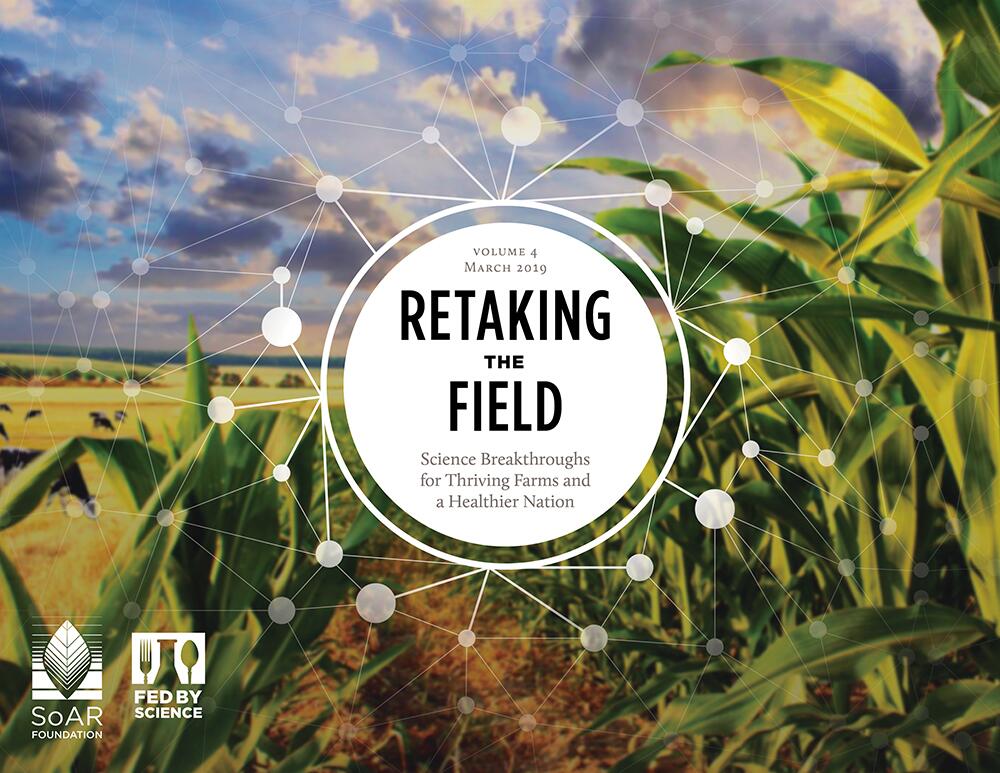Illinois featured in new report identifying how to supercharge ag science in the US

URBANA, Ill. – A new report issued today showed how U.S. farmers—facing a surge of weather events and disease outbreaks—can increase production and revenues with innovations produced by federally funded agricultural research.
The U.S. needs to increase its investment in agricultural research or it risks falling further behind China, according to a new report issued by the Supporters of Agricultural Research (SoAR) Foundation and 20 FedByScienceresearch institutions.
The new report, Retaking the Field: Science Breakthroughs for Thriving Farms and a Healthier Nation, highlights research projects in the five Science Breakthroughs areasidentified as the most important fields to advance in agriculture by the year 2030: genomics, microbiomes, sensors, data and informatics, and transdisciplinary research. These areas were determined by the National Academies of Sciences, Engineering, and Medicine (NASEM) as part of a widespread scientific effort to prioritize agricultural research endeavors.
Researchers in the College of Agricultural, Consumer and Environmental Sciences at the University of Illinois lead in all five Science Breakthroughs areas, but the project selected for inclusion in Retaking the Field is in the area of data and informatics, using supercomputers and infrared heating arrays to predict the effect of climate change on soybean crop production.
Kaiyu Guan, assistant professor in the Department of Natural Resources and Environmental Sciences and Blue Waters Professor at the National Center for Supercomputing Applications at Illinois, is using computer modeling and field data to analyze how high temperature affects major plant processes such as photosynthesis, respiration, and reproductive processes in soybeans. This will lead to improved crop breeding, more accurate yield predictions, and better management recommendations.
“I have a dream that moving forward, we will be able to monitor and model every field on this planet. We will know crop conditions, yields, and most importantly how much water and fertilizer crops require. Our research is progressing in that direction,” Guan said.
The project is also led by U of I plant physiologists Lisa Ainsworth and Carl Bernacchi, as well as ecosystem modeler Bin Peng from Guan’s lab.
Thomas Grumbly, SoAR’s president, said, “Investments in these five science breakthroughs will allow us to achieve a number of broader goals for food and agriculture in the U.S. in the next decade. But these advancements aren’t possible without federal funding for the research needed to tackle agriculture’s greatest problems. Farmers are getting hammered right now and they need innovation to at least soften the blows.”
Representatives from the agricultural and science sectors reconvened earlier this year to identify research goals that can only be achieved through advancing the five science breakthrough areas. By 2030, innovations in agricultural research like the projects highlighted in this report can:
- Reduce water use in agriculture by 20 percent
- Reduce fertilizer use by 15 percent
- Significantly reduce the need for fungicides and pesticides in plant production
- Radically reduce the incidence of infectious disease epidemics for livestock
- Reduce incidence of foodborne illnesses by 50 percent
- Increase the availability of new plant varieties and animal products to deliver food with enhanced nutrient content
“Now is the time to double down on federal investments in agricultural research,” Grumbly said. “There are urgent needs to produce more food, fiber and fuel while consuming fewer resources and protecting public health in the face of existing and emerging threats.”
The report shows how scientists funded by USDA’s National Institute of Food and Agriculture (NIFA) are leveraging federal resources to advance the five breakthroughs areas. Along with Guan, featured researchers and their teams working on food and agricultural breakthroughs include:
Genomics
- Stephen Baenziger, Ph.D., University of Nebraska-Lincoln—Creating hybrid wheat for improved productivity and nutrition
- Jack Dekkers, Ph.D., Iowa State University—Using genetics to improve animal health and disease resistance in pigs
- Fred Gmitter, Ph.D., University of Florida—Protecting oranges by boosting resistance to citrus greening
- Jennifer Randall, Ph.D., New Mexico State University—Leveraging genetics to defend pecan trees against disease and extreme weather
Microbiomes
- Michela Centinari, Ph.D., Penn State—Harnessing soil and root microbiomes to increase crop productivity
- Phillip Myer, Ph.D., University of Tennessee—Improving feed efficiency and nutrition for sustainable beef
- Gretchen Sassenrath, Ph.D., Kansas State University—Leveraging the soil microbiome to fight plant diseases
- Kate Scow, Ph.D., University of California, Davis—Working with farmers to improve soil health
Sensors
- Ralph Dean, Ph.D., North Carolina State University—Deploying sensors to safeguard the food supply
- Katy Martin Rainey, Ph.D., Purdue University—Using drones and computer analysis to evaluate new plant varieties
- Abe Stroock, Ph.D., Cornell University—Developing sensors for precision irrigation technology
- Archie Williams, Ph.D., Fort Valley State University—Helping farmers use drones to improve efficiency
Data and Informatics
- Lingxiu Dong, Ph.D., and Durai Sundaramoorthi, Ph.D., Washington University in St. Louis—Using digital tools to help farmers plant the right seeds
- Kaiyu Guan, Ph.D., University of Illinois at Urbana-Champaign—Leveraging super computers to predict crop yields and water requirements
- Raj Khosla, Ph.D., Colorado State University—Using satellite data to manage water and fertilizer use
- Ignacy Misztal, Ph.D., University of Georgia—Developing new tools to understand animal genetics
- Robin White, Ph.D., Virginia Tech—Using computing technology to individualize livestock diets
Transdisciplinary Research
- Rufus Isaacs, Ph.D., Michigan State University—Improving bee health to benefit farmers
- Cristine Morgan, Ph.D., Texas A&M University—Improving the way scientists measure and communicate the value of soil
- Matthew Ruark, Ph.D., University of Wisconsin-Madison—Connecting expertise to reduce greenhouse gas emissions